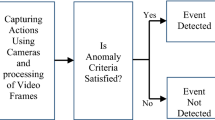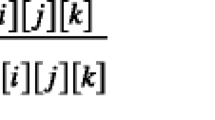Abstract
We present a new method for detection of abnormal behaviors in crowded scenes. Based on statistics of low-level feature—optical flow, which describes human movement efficiently, the motion energy model is proposed to represent the local motion pattern in the crowd. The model stresses the difference between normal and abnormal behaviors by considering sum of square differences (SSD) metric of motion information in the center block and its neighboring blocks. Meanwhile, data increasing rate is introduced to filter outliers to achieve boundary values between abnormal and normal motion patterns. In this model, an abnormal behavior is detected if the occurrence probability of anomaly is higher than a preset threshold, namely the motion energy value of its corresponding block is higher than that of the normal one. We evaluate the proposed method on two public available datasets, showing competitive performance with respect to state-of-the-art approaches not only in detection accuracy, but also in computational efficiency.









Similar content being viewed by others
References
Adam A, Rivlin E, Shimshoni I, Reinitz D (2007) Robust real-time unusual event detection using multiple fixed-location monitors. IEEE Trans Pattern Anal Mach Intell 30(3):555–560
Basharat A, Gritai A, Shah M (2008) Learning object motion patterns for anomaly detection and improved object detection, pp 1–8
Chan AB, Vasconcelos N (2005) Mixtures of dynamic textures Tenth IEEE International Conference on Computer Vision, pp 641–647
Chaudhry R, Ravichandran A, Hager G, Vidal R (2009) Histograms of oriented optical flow and binet-cauchy kernels on nonlinear dynamical systems for the recognition of human actions. 94(10):1932–1939
Cong Y, Yuan J, Liu J (2011) Sparse reconstruction cost for abnormal event detection. 32(14):3449–3456
Hamalainen W, Nykanen M (2008) Efficient discovery of statistically significant association rules, pp 203–212
Helbing D, Molnr P (1995) Social force model for pedestrian dynamics. Phys Rev E Stat Phys Plasmas Fluids Relat Interdiscip Top 51(5):4282–4286
Kaltsa V, Briassouli A, Kompatsiaris I, Hadjileontiadis LJ, Strintzis M (2015) Swarm intelligence for detecting interesting events in crowded environments. IEEE Trans Image Process A Publ IEEE Signal Process Soc 24(7):2153
Kim J, Grauman K (2009) Observe locally, infer globally: A space-time mrf for detecting abnormal activities with incremental updates IEEE Conference on computer vision and pattern recognition, pp 2921–2928
Kuettel D, Breitenstein MD, Van Gool L, Ferrari V (2010) What’s going on? Discovering spatio-temporal dependencies in dynamic scenes. 10(9):1951–1958
Kwon J, Lee KM (2012) A unified framework for event summarization and rare event detection from multiple views. 37(9):1266–1273
Lee DG, Suk HI, Lee SW (2013) Crowd behavior representation using motion influence matrix for anomaly detection Iapr Asian conference on pattern recognition, pp 110–114
Lee Kyoung Mu, Kwon Junseok (2015) A unified framework for event summarization and rare event detection IEEE Conference on computer vision and pattern recognition, pp 1737–50
Li W, Mahadevan V, Vasconcelos N (2013) Anomaly detection and localization in crowded scenes. IEEE Trans Pattern Anal Mach Intell 36(1):18–32
Mahadevan Vijay, Li Weixin, Bhalodia Viral, Vasconcelos Nuno (2010) Anomaly detection in crowded scenes IEEE Conference on computer vision and pattern recognition, pp 1975–1981
Nguyen NT, Phung DQ, Venkatesh S, Bui H (2005) Learning and detecting activities from movement trajectories using the hierarchical hidden markov model IEEE Computer society conference on computer vision and pattern recognition, vol 2, pp 955–960
Piciarelli Claudio, Micheloni Christian, Foresti Gian Luca (2008) Trajectory-based anomalous event detection. IEEE Trans Circ Syst Video Technol 18 (11):1544–1554
Reddy V, Sanderson C, Lovell BC (2011) Improved anomaly detection in crowded scenes via cell-based analysis of foreground speed, size and texture, pp 55–61
Roshtkhari M, Levine M (2013) Online dominant and anomalous behavior detection in videos Computer Vision and Pattern Recognition, pp 2611–2618
Shandong W, Moore BE, Shah M (2010) Chaotic invariants of lagrangian particle trajectories for anomaly detection in crowded scenes Computer Vision and Pattern Recognition, pp 2054–2060
Song J, Gao L, Nie F, Shen H, Yan Y, Sebe N (2016) Optimized graph learning with partial tags and multiple features for image and video annotation. IEEE Trans Image Process A Publ IEEE Signal Process Soc 25(11):4999–5011
Song J, Guo Z, Gao L, Liu W, Zhang D, Shen HT (2017) Hierarchical lstm with adjusted temporal attention for video captioning
Tran D, Yuan J, Forsyth D (2014) Video event detection: From subvolume localization to spatiotemporal path search. IEEE Trans Pattern Anal Mach Intell 36 (2):404–416
Ucsd anomaly dataset. http://www.svcl.ucsd.edu/projects/anomaly
Umn anomaly dataset. http://mha.cs.umn.edu/Movies/Crowd-Activity-All.avi
Wang X, Gao L, Song J, Shen H (2017) Beyond frame-level cnn: Saliency-aware 3-d cnn with lstm for video action recognition. IEEE Signal Process Lett 24(4):510–514
Xu D, Ricci E, Yan Y, Song J, Sebe N (2015) Learning deep representations of appearance and motion for anomalous event detection
Zhang Y, Huchuan L, Zhang L, Xiang R (2016) Combining motion and appearance cues for anomaly detection. Pattern Recogn 51(C):443–452
Zhou S, Shen W, Zeng D, Fang M, Wei Y, Zhang Z (2016) Spatial-temporal convolutional neural networks for anomaly detection and localization in crowded scenes. Signal Process Image Commun 47:358–368
Acknowledgements
This work was supported by the National Natural Science Foundation of China under Grant 61471262, the International (Regional) Cooperation and Exchange under Grant 61520106002, and the Doctoral Fund of Ministry of Education of China under Grant 20130032110010.
Author information
Authors and Affiliations
Corresponding author
Rights and permissions
About this article
Cite this article
Chen, T., Hou, C., Wang, Z. et al. Anomaly detection in crowded scenes using motion energy model. Multimed Tools Appl 77, 14137–14152 (2018). https://doi.org/10.1007/s11042-017-5020-3
Received:
Revised:
Accepted:
Published:
Issue Date:
DOI: https://doi.org/10.1007/s11042-017-5020-3




